Explore the spiritual legacy, architecture, and travel insights of Badrinath Temple. Dive deep into the heart of the Himalayas and experience divine peace.
Imagine you’re standing in front of the Badrinath Temple, way up there – like, 10,000 feet in the sky. The kind of place where you’re catching your breath, and it’s not just the altitude. Snowy peaks all around, Alaknanda River just roaring away below.
What is it about Badrinath that kept people coming back for centuries? It’s not just the spirituality or the architecture (which, by the way, is stunning). Doesn’t matter if you’re on a soul-searching journey or just passing through, there’s something here that’ll probably stick with you.
Mythology of Badrinath Temple: Where Gods Meditate and Time Stands Still
The mythology of Badrinath Temple is not just an old story from scriptures – it is a rich blend of Vedic wisdom, Puranic tales, and deep yogic philosophy.
According to the Bhagavata Purana, in Badrikashram, Lord Vishnu took the form of the sages Nara and Narayana and performed deep penance for a very long time to bless and protect all living beings.
The Lakshmi Connection: The Divine Shelter
One of the most touching tales speaks of Goddess Lakshmi, who transformed herself into a Badri tree to protect her meditating consort, Vishnu, from the harsh Himalayan weather. Hence, he became Badri-Nath – Lord of Badri. This tale subtly illustrates the active-shakti principle, where Lakshmi (divine energy) enables Vishnu (consciousness) to remain stable in mystical stillness.
Interestingly, the word Badri in Sanskrit refers to the Jujube tree (Ziziphus jujuba), a symbol of nourishment and spiritual sustenance. This reinforces the idea of the goddess as a nurturing force in spiritual pursuit.
Skanda Purana and the Panch Badri Connection
In the Skanda Purana, Badrikashram is described as the supreme place for Vishnu’s tapasya. It is part of the Panch Badri, a group of five sacred Vishnu shrines in the region:
- Adi Badri (One of the most ancient Vedic religious site in Haryana, linked to the early Vedic period)
- Bhavishya Badri (The temple of Bhavishya Badri is at Subain, about 17 Kms from Joshimath to the east toward Lata.)
- Vridha Badri (Located at Animath in Chamoli district of Uttarakhand.)
- Yogadhyan Badri (Located in Pandukeshwar equi-distance between Joshimath and Badrinath., where Pandavas installed Vishnu’s image)
- Badrinath (the chief among them)
Each shrine reflects a different aspect of Vishnu’s presence through time – past, present, and future.
Adi Shankaracharya and the Lost Idol
Historically speaking, the black Shaligram idol of Lord Badrinarayan, enshrined in today’s temple, was rediscovered by Adi Shankaracharya in the 8th century CE. Legend says he found it submerged in the Alaknanda River, guided by a divine vision. He established it in a cave and initiated the modern pilgrimage tradition.
The Pandava Connection: Echoes from Mahabharata
The Mahabharata references Badrinath as the site where the Pandavas passed during their final ascent to the heavens (Swargarohini Yatra). It is said that Yudhishthira, the eldest Pandava, meditated here before taking the path toward Swarga (heaven). The nearby Satopanth Lake is named after the divine trinity – Satya (Brahma), Tap (Shiva), and Anth (Vishnu) – who are believed to meditate there in eternal stillness.
From yogic discipline to divine love and cosmic balance, the mythology of Badrinath surpasses a simple narrative – it embodies the core essence of Sanatana Dharma: harmony between form and formless, action and stillness, the seeker and the divine.
Historical Background of Badrinath Temple
Tracing the evolution of the Badrinath Temple offers a compelling view into the religious, political, and cultural dynamics of northern India. Unlike many temples that were constructed in a single architectural or dynastic phase, Badrinath’s history is marked by cyclical rediscoveries, destructions, and restorations – each phase adding a new layer to its sanctity. It forms a key node in India’s Char Dham Yatra, alongside Rameswaram, Dwarka, and Puri.
Early Roots in Vedic Literature
While no physical temple structure can be traced back to the Vedic period, textual references to Badrikashram appear in ancient scriptures like the Rigveda, Mahabharata, and Skanda Purana. The Mahabharata speaks of the Pandavas passing through this region during their final journey (Mahaprasthan), which indicates its sanctity even in epic-era consciousness.
Moreover, the Skanda Purana (Kedar Khand) extensively describes Badrinath as the place where Nara-Narayana performed penance, elevating the region to a Tirtha of Moksha (salvation).
Revival by Adi Shankaracharya – 8th Century CE
The formal re-establishment of the temple as we know it today is credited to Adi Shankaracharya, the 8th-century philosopher and reformer. During his pan-Indian mission to revive Sanatana Dharma, Shankaracharya reportedly found a black Shaligram idol of Lord Badrinarayan in the Alaknanda River, concealed and neglected due to changing religious tides and natural challenges.
Patronage of Katyuri and Garhwal Kings – 10th to 18th Century
Following Shankaracharya’s revival, regional dynasties began to support the temple. The Katyuri rulers of Kumaon, who governed large parts of Uttarakhand between the 10th and 13th centuries, likely extended early patronage, although direct inscriptions are rare.
The more significant phase began with the Garhwal dynasty, especially under rulers like Raja Man Shah (17th century) and Pradyumna Shah, who provided endowments and protection. These kings maintained pilgrim infrastructure, regulated routes, and financed temple repairs – laying foundations for the temple’s continued prominence.
Islamic Invasions and Natural Disasters
Interestingly, Badrinath, due to its remote Himalayan location, escaped large-scale destruction during the Islamic invasions that affected plains-based temples like Somnath or Mathura. However, it did suffer from avalanches, earthquakes, and glacial shifts, which impelled frequent rebuilding.
Records from British travelers in the 19th century – like Captain Henry Raper (1810) and E.T. Atkinson – describe the temple as modest but spiritually significant, with difficult access that kept it insulated from colonial commercialization.
Modern Era and State Involvement – 20th Century Onwards
Post-independence, the administration of the temple came under the Uttarakhand Char Dham Devasthanam Board. Significant renovations were undertaken in the 1950s and 1980s, and the Government of India promoted the Char Dham Highway Project in the 21st century to improve access.
The idol of Badrinarayan is now ceremonially moved to Narsingh Temple in Joshimath during winter when Badrinath becomes inaccessible due to snow.
Geographical Location of Badrinath Temple
Badrinath Temple sits gracefully in the lap of the Garhwal Himalayas, in the Chamoli district of Uttarakhand, India. Rested at an altitude of approximately 3,133 meters (10,279 feet) above sea level, this ancient shrine is settled on the left bank of the Alaknanda River, one of the sacred tributaries of the Ganga.
Surrounded by majestic snow-capped peaks and serene alpine landscapes, the temple lies between Nar and Narayan mountain ranges, believed in scriptures to be the divine abode of the twin sages who meditated in service of Lord Vishnu. Towering behind the temple is the iconic Neelkanth Peak, standing tall at 6,597 meters – glowing golden at sunrise, casting a spell that words can hardly capture.
Architectural Grace in the Lap of Nature
The temple’s architecture is a fascinating blend of Garhwali wooden aesthetics and classic North Indian stone carvings. Reconstructed over centuries, the temple retains its charm despite facing multiple natural calamities. What’s particularly striking is how the temple harmonizes with the harsh Himalayan environment, a testament to the ancient builders’ creativity.
Style and Structure: A Unique Garhwali Synthesis
The current temple structure exhibits a blend of North Indian Nagara style and traditional wooden Garhwali architecture – adapted for seismic activity and extreme cold. Unlike the stone-heavy temples of the plains, Badrinath stands on a base of stone masonry, with its upper portions reconstructed multiple times using wood and mortar due to environmental wear.
- Height: Approximately 50 feet
- Shikhara (spire): Painted gold atop a tiered roof with a stupa-like structure, uncommon in mainstream Hindu temples
- Facade: The temple’s front is made of stone and decorated with arched windows. A wide staircase leads to the main entrance, which is a tall arched gateway. Inside, there is a mandap-a spacious hall with many pillars-that connects to the sanctum, or main shrine. The walls and pillars of this hall are beautifully decorated with detailed carvings
Layout: Symbolic Spatial Divisions
The temple follows a three-part layout – each corresponding to stages of spiritual evolution:
Garbhagriha (Sanctum):
The sanctum, or garbhagriha, has a conical-shaped roof about 15 meters (49 feet) high. On top sits a small cupola, which is covered with a golden roof.
Inside the main shrine is a 1-foot (0.30 m) Shaligram, a black stone idol of Lord Badrinarayana. The idol is placed under a golden canopy beneath a Badri tree. Lord Badrinarayana is shown holding a Shankha (conch) and a Chakra (wheel) in two raised hands, while his other two hands rest on his lap in a Yogamudra (Padmasana) posture.
Darshan Mandap:
The pillared hall where rituals and pujas are performed. The structure is simple, with stone flooring and high-vaulted ceilings to accommodate chanting amplification. No intricate carvings – this is a place of prayer, not spectacle.
Sabha Mandap:
A wider hall for devotees to assemble. Wooden columns, engraved with modest designs, provide structural stability while keeping the space warm and enclosed.
Tapt Kund and Water Architecture
Just below the temple lies the Tapt Kund, a group of hot sulphur springs believed to have healing powers. Pilgrims usually take a dip here before entering the temple, as it is considered a sacred ritual. The springs remain at a steady 55 °C (131 °F) throughout the year, even though the outside temperature usually stays below 17 °C (63 °F). Within the temple complex, there are also two water ponds known as Narad Kund and Surya Kund.
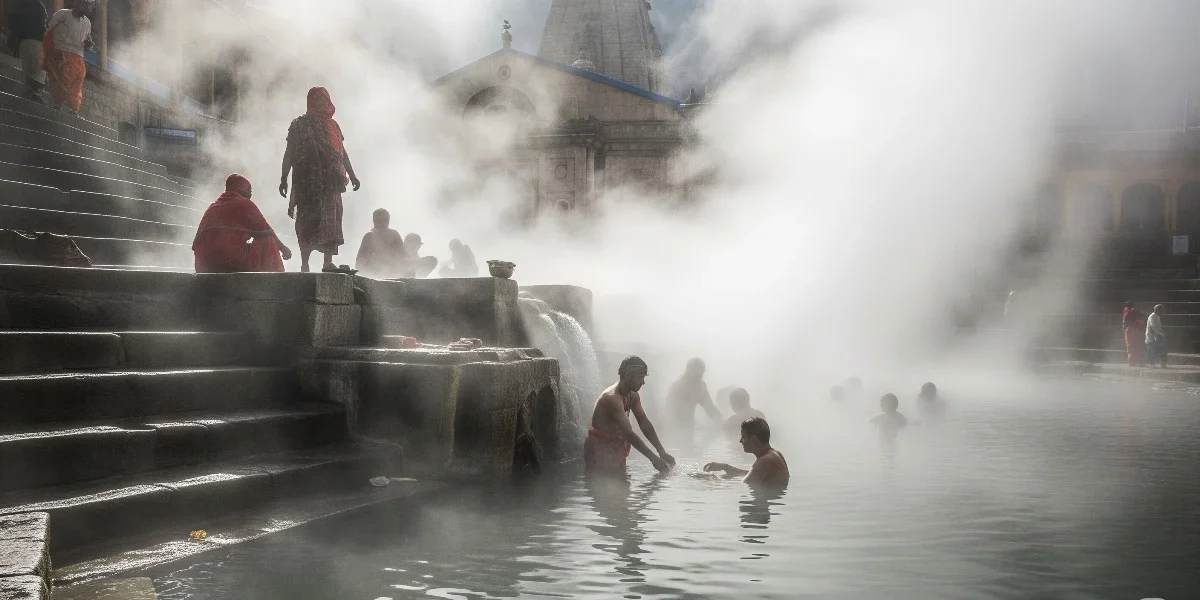
Architecturally, the steps around Tapt Kund are made of local slate stone, weather-resistant and grooved to prevent slipping. Ritual bathing here before entering the temple is a tradition dating back over a thousand years.
Structural Resilience and Restoration
Due to its high-altitude location (10,279 ft), the temple has faced multiple reconstructions. Historical and satellite data suggest repeated damages due to:
- Earthquakes (notably 1803 Garhwal quake)
- Avalanches and floods
- Severe winters requiring seasonal closure
The structure we see today is a 20th-century reconstruction, carefully replicating earlier foundations. Archaeological surveys confirm that many original elements were preserved and reused – especially the stone platform and base layers.
The best time to admire the temple’s architectural brilliance is during early morning Aarti when the light enhances the intricate designs.
The Spiritual Experience: Beyond Rituals
The vibe at Badrinath Temple is palpably different. It isn’t just the chants or the crisp mountain air – it’s the feeling of being in the presence of something eternal.
Must-Experience Rituals:
- Maha Abhishek: It is the most sacred and elaborate ritual performed daily at the Badrinath Temple, especially revered during the early morning hours at 4:30 AM. This elaborate ritual is a visual and spiritual delight. Conducted by Kerala Namboodiri Brahmins, following strict purification protocols.
- Evening Aarti: As twilight paints the snow-capped peaks in golden hues, the Evening Aarti at Badrinath Temple transforms the sacred space into a realm of pure devotion. Begins around 6:30 PM, after sunset. Performed by the Rawal (chief priest) with support from other temple priests. The sound of conch shells, bells, and synchronized mantras echo through the valley.
For an immersive guide to the rituals, the official Badrinath portal is highly resourceful.
A Personal Encounter: Walking Through the Clouds
My journey from Joshimath to Badrinath felt like being transported through clouds. The winding roads, rhythmic chants of co-travelers, and the sudden appearance of the colorful temple facade amidst white fog was unforgettable.
I recall sitting by the Alaknanda post darshan, watching pilgrims perform rituals in silent reverence. There was no rush, no noise – just a shared, sacred stillness.
This trip taught me that Badrinath Temple isn’t just about faith; it’s about finding stillness in motion, clarity in chaos.
Practical Travel Guide to Badrinath Temple
Best Time to Visit
- May to June & September to October: Clear skies, moderate temperatures.
- Avoid July-August: Monsoon risks and landslides.
How to Reach
Reaching Badrinath Temple, settled in the heart of the Garhwal Himalayas, is an adventure in itself – a spiritual and scenic journey that begins long before the first glimpse of the shrine.
- By Air: Nearest airport is Jolly Grant (Dehradun) – 310 km away. Charter Helicopter services available from Dehradun during peak season.
- By Road: Well-connected from Haridwar, Rishikesh, and Joshimath. Nearest Bus Station is – Garhwal.
- By Rail: Nearest Railway Station – Rishikesh.
My Journey From Kolkata to Haridwar
My pilgrimage began from Kolkata, where I boarded the Howrah-Dehradun Express – a comfortable train that reaches Haridwar in about 33–34 hours. The long ride was meditative in its own way – watching the plains of northern India pass by, feeling the anticipation rise with every mile.
Before ascending into the sacred Himalayas, I chose to halt at Haridwar – not just to rest, but to absorb the spiritual energy of a city that marks the starting point of many pilgrimages. Here, where the Ganga flows from the hills into the plains, everything feels divinely orchestrated.
One Night Stay at Haridwar: A Spiritual Prelude
I checked into Hotel Har Ki Pauri, a well-maintained hotel conveniently located just a few minutes’ walk from the iconic ghat. The room was clean, comfortable, and offered a partial view of the river. The location – right in the spiritual heart of Haridwar – made it an ideal choice for a pilgrim like me.
Evening Aarti at Har Ki Pauri
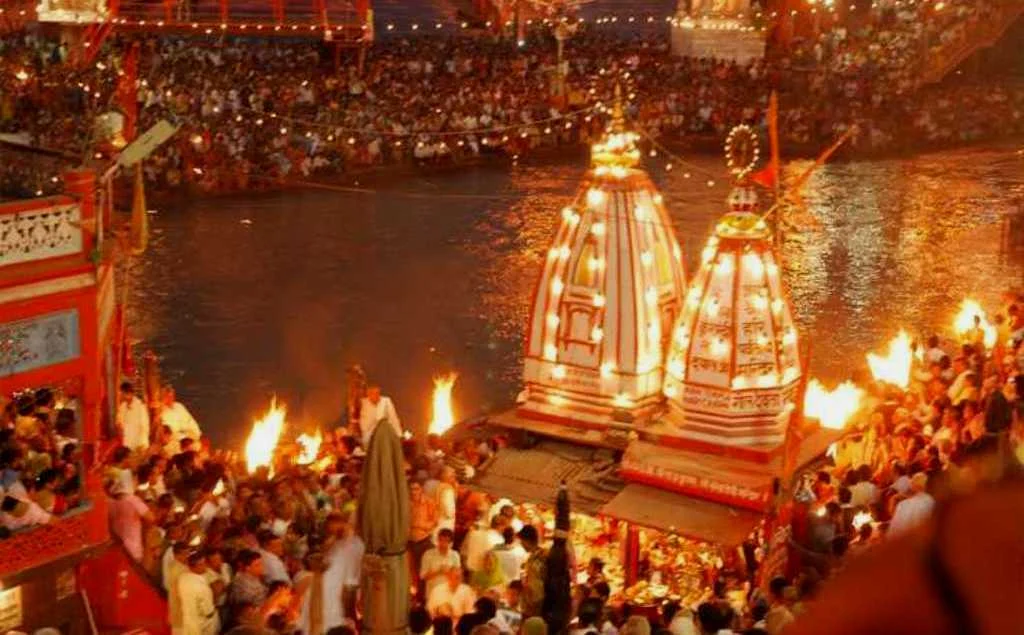
As the sun dipped behind the horizon, I joined the growing crowd at Har Ki Pauri. The evening Ganga Aarti was breathtaking. Priests in synchronized movements offered blazing lamps to the river, as conch shells echoed and chants filled the air. I lit a diya, placed it in the flowing Ganga, and watched it drift away – a small offering carried by the sacred current.
That night in Haridwar didn’t just offer rest – it offered a reset. In many ways, it felt like Lord Vishnu was inviting me forward, one peaceful step at a time, toward Badrinath.
Haridwar to Badrinath by Road
The next morning, I hired a shared SUV from Haridwar, as direct buses are limited. The road trip to Badrinath spans roughly 320 km, broken into winding mountain roads, river valleys, and scenic halts.
Route:
Haridwar → Rishikesh → Devprayag → Rudraprayag → Karnaprayag → Joshimath → Badrinath
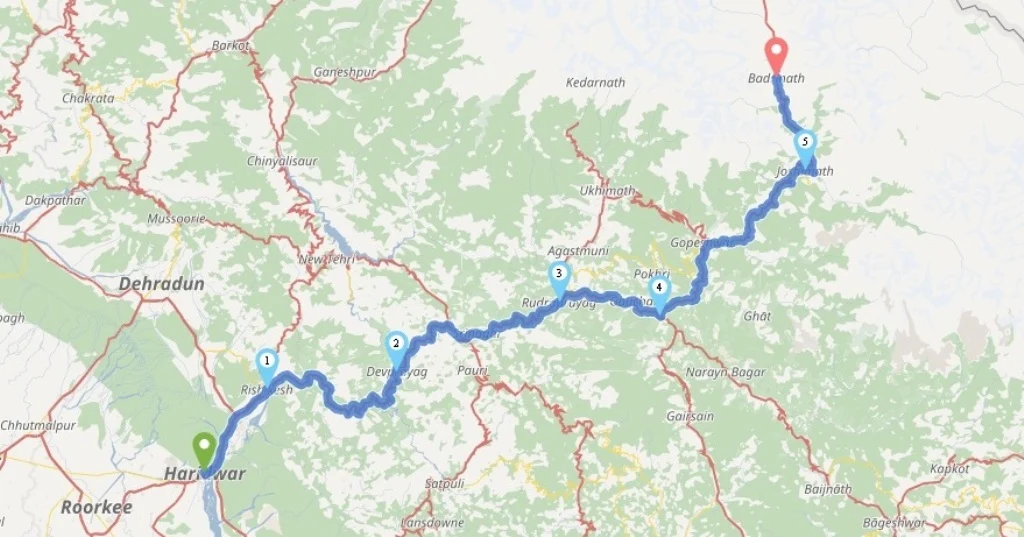
- Total Duration: 10–12 hours (may vary based on landslides or traffic)
- Distance: ~320 km
- Best Travel Time: Early morning to avoid evening fog and possible blockages
We stopped at Rudraprayag for breakfast by the confluence of the Mandakini and Alaknanda rivers, and at Joshimath for a short break and tea.
Optional Stopover: Joshimath
If you prefer not to cover the distance in one stretch, Joshimath is the perfect place to halt. It’s only 45 km from Badrinath and offers accommodation, local temples like Narsingh Mandir, and cable car access to Auli.
I personally recommend staying here overnight to acclimatize – especially if you’re sensitive to altitude changes.
Alternative Travel Options:
By Helicopter:
Charter helicopter services operate from Dehradun, Guptkashi, and Phata (seasonal, weather-dependent). Ideal for elderly pilgrims or tight itineraries.
By Car Rental:
From Haridwar/Rishikesh, private car rentals with experienced drivers are easily available. Choose a 4×4 or high-clearance vehicle, especially post-monsoon.
Char Dham Yatra Buses:
During Yatra season (April–October), government and private buses run on scheduled circuits. They’re affordable but take longer due to fixed stops.
Where to Stay in Badrinath
Finding a place to stay in Badrinath is not about luxury – it’s about proximity to the divine and peace amid the Himalayas. Accommodation options here are designed more for spiritual comfort than luxury. Yet, you’ll find plenty of clean, functional, and even scenic places that offer warmth and rest after a long journey.
During my visit, I stayed at the GMVN Tourist Rest House (Garhwal Mandal Vikas Nigam), a government-run guesthouse just a short walk from the temple. Despite its basic infrastructure, it provided everything a pilgrim needs – clean beds, geysers for hot water, hearty food, and an incredible view of the snow-clad Neelkanth peak right from the courtyard.
The room was simple but spacious, and the staff – locals from nearby villages – were warm and attentive. Early mornings were especially magical; I’d wake up to temple bells ringing and watch the first sunlight bathe the Badrinath shrine in gold.
Other Recommended Stay Options:
Hotel Narayan Palace: The hotel is about 15-20 min walk from the temple. Offering decent rooms and good food.
Hotel Dwarikesh: Reasonably clean, well located near the bus stand, the temple is 10-15 minute walk away.
Buddyhikers stay Badrinath: Perfect location, more or less same distance to both Badrinath Temple and Mana Village.
✅ Book accommodations and temple entry slots online during peak Yatra season.
Unique Insights & Hidden Gems
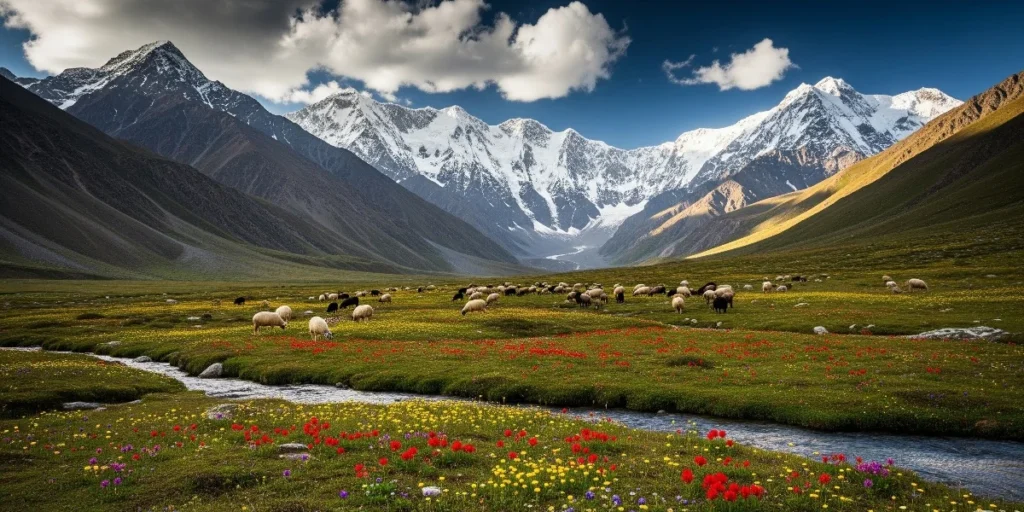
- Mana Village: The last Indian village before the Tibetan border, just 3 km away. Don’t miss the Vyas Gufa (cave where Ved Vyas composed the Mahabharata).
- Charan Paduka: A boulder with what is believed to be Lord Vishnu’s footprints.
- Satopanth Lake: A challenging trek for adventure lovers, believed to be the spot where the Trimurti (Brahma, Vishnu, Shiva) meditated.
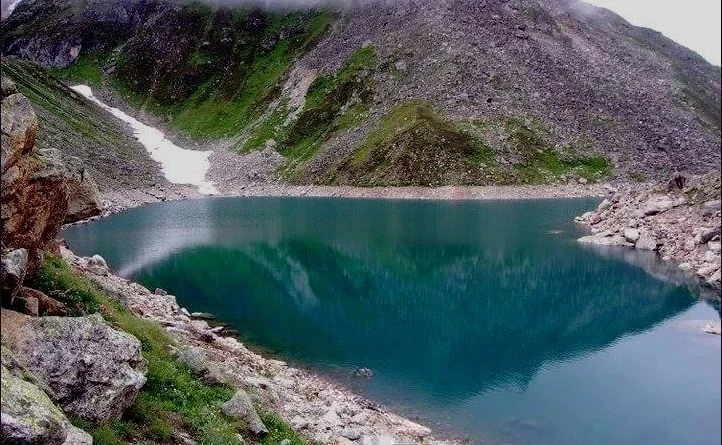
These places provide a deeper immersion into the mythical geography of Badrinath.
Why Badrinath Temple is More Relevant Than Ever
In an age dominated by screens and schedules, Badrinath Temple offers a rare escape into the timeless. It’s not merely a religious site but a portal into India’s spiritual, cultural, and ecological heart.
From its divine lore and resilient architecture to its serene setting and inclusive aura, Badrinath Temple beckons all – not just the faithful, but the curious, the lost, and the hopeful.
May your journey to Badrinath Temple be as enlightening as it is breathtaking.
External References to Deepen Your Exploration
Uttarakhand Tourism Official Portal
FAQs:
Badrinath Temple is open only six months a year, typically from April/May (around Akshaya Tritiya) to October/November (around Vijayadashami or Bhai Dooj). Daily darshan timings are usually from 4:30 AM to 1:00 PM, then from 4:00 PM to 9:00 PM, with a midday break
Yes. Morning rituals include Maha Abhishek, Abhishek, Gita Path, and Bhagavat Puja, while evening rituals feature Geet Govinda and Aarti. Vedic chants like Ashtotram and Sahasranama are recited during all rituals. Devotees also receive the sandalwood paste applied to the deity as Nirmalaya Prasad the following day.
Yes, it is possible to drive to Badrinath by car, but it’s recommended to travel during the open season (May to October) when the roads are accessible and the temple is open.
The Badrinath Yatra, a part of the revered Chardham Yatra, is a pilgrimage to the Badrinath Temple in Uttarakhand. Registration for the Badrinath Yatra is mandatory.
No, Badrinath is not one of the 12 Jyotirlingas. It is a temple dedicated to Lord Vishnu, while the Jyotirlingas are dedicated to Lord Shiva.
The road distance between Kedarnath and Badrinath is approximately 218 kilometers (135 miles). The journey typically takes around 5-6 hours by road.
Badrinath VIP Darshan can cost anywhere from Rs.1100 – Rs.5100 per person. This ticket allows devotees faster entry with minimal waiting.
The mountain prominently visible behind the Badrinath Temple is Neelkanth Peak. It’s a pyramidal-shaped, snow-capped peak in the Garhwal Himalayas, Uttarakhand.

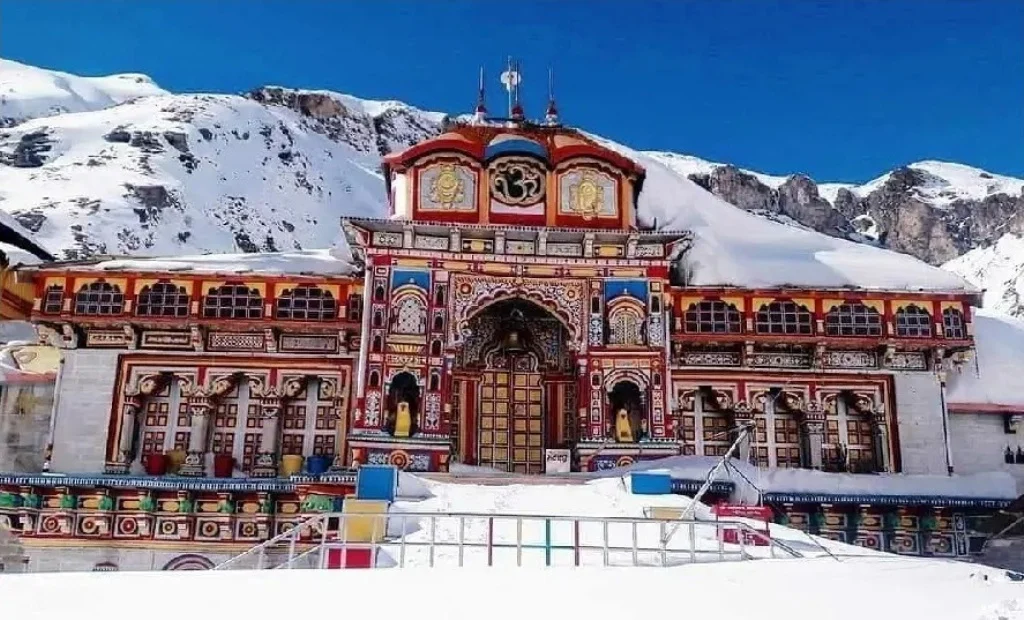

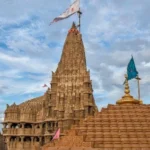
Pingback: Dwarka: Where Myth Meets the Arabian Sea - Temples of India